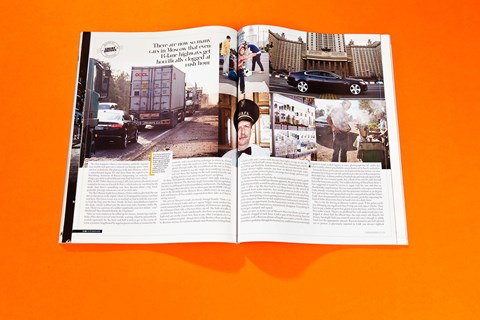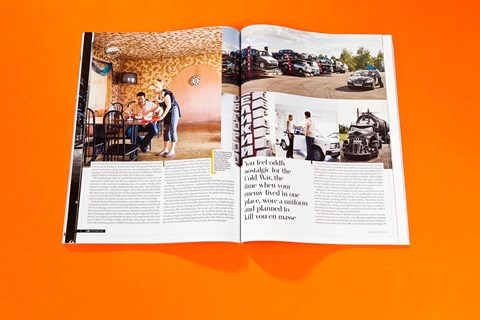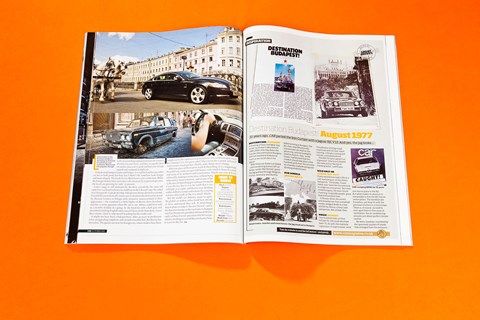► In 1977, CAR penetrated the Iron Curtain in a Jaguar XJC
► Quite risky in those days…
► Will trying it again in a new Jaguar XF be any easier?
Forget the salt mines and the gulags and the 17 subterranean floors of cells beneath the KGB’s infamous Lubyanka headquarters. They’re nothing compared with the misery and torture the Soviets had in store for a comrade who tired of walking and waiting for hours for trains and trams in minus-20 Moscow, and who aspired to own an automobile.
First, he would have to get his name on a waiting list; difficult, but the payment of a large bribe helped. Then – after only five years if he was lucky – he might be issued with an abominable, antiquated Lada or Volga, the auto equivalent of thin cabbage soup. He would have to pay, in one lump sum, around two years’ wages, which equates to more than £50,000 in modern Britain. To fund this, he would club together with friends and family and do some illegal minicabbing on the side. In return, he got a car which he would fully expect to have to repair before he could drive it for the first time, and weld up before he’d trust his family to it.
We’re not talking about the privations of the post-war Stalinist era here; this is how things were for Russian motorists right up until the end of the Soviet Union in 1991. We’d wanted to recreate CAR’s unprecedented road trip behind the Iron Curtain to Budapest in a Jaguar XJC in 1977, but eastern Europe is now too easy, so we headed for Russia. And there’s a much bigger story to be told there. In just 17 years, Russian car culture has been transformed.
On the day we flew into Moscow, figures were published showing that, from virtually a standing start in 1991, Russia had overtaken Germany as Europe’s largest car market in the first half of 2008. It is growing so fast that, just last year, the same analysts thought that it would take until 2011 for this to happen. Nearly four million cars were sold in Russia last year, almost twice as many as in the UK. By 2012, only the USA and China will be bigger.
So what happens when a vast country suddenly acquires vast wealth and goes on a colossal car-buying spree? Only one way to find out. The plan was to fly into Moscow, collect a supercharged Jaguar XF and drive from the capital to St Petersburg, mainstay of Russia’s burgeoning car industry, along a 450-mile road we’d heard some bad, bad stories about. Why an XF? We wanted to be sure we’d reach St Pete’s, which rules out anything locally made. And there’s something very New Russian about a big, black, powerful, prestige saloon on a set of 20-inch rims.
The New Russia might have chosen a better ambassador than the taxi driver who met us at the airport, where we’d emerged into intense sunshine and heat. His Focus estate was so trashed we had to fold the rear seats to load the bags into the boot. Inside, he had a knuckleduster taped to the dash, a knife stabbed into the door trim and a hammer under the seat. There was a picture of a soldier taped to the rear view mirror – son? Boyfriend? Best friend killed by the Chechens?

Once we were underway he rolled up his sleeves, trouser legs and the body of his shirt to reveal some horrific scarring, which he proceeded to scratch vigorously for the hour-and-half it took to get to the centre of town, a journey lengthened by regular pauses to shout at women by the roadside, and a novel driving technique in which he slowed to 20mph when the road was clear, then weaved at insane speeds through traffic like a crackhead on the run in Police! Camera! Action! It was the single most terrifying taxi ride I will ever have.
In those brief periods when my eyes weren’t shut tight with fear, I marvelled at Moscow. The Russians might have come late to capitalism but they’ve embraced it with extraordinary enthusiasm. The billboards here are bigger than anywhere else; we drove past one for BMW’s M-cars next to the Kremlin on the Moscow River, which covers an acre and a half and features all four models suspended on their sides as if they’re racing across it.
The cars on Moscow’s roads are mostly foreign brands. There is an underclass of ancient Ladas and vast, square Volgas, more modern but utterly unremarkable Lada hatches, and plenty of Chinese cars, including the infamous Chery QQ, a Daewoo Matiz rip-off. The bulk of traffic is standard-fare Toyotas, Fords and Renaults, but there are probably more high-end cars on the streets here than in any other European city I’ve been to, London excepted – though most of the Bentleys there are driven by Russians anyway. Government officials treat themselves to long black S-classes, A8s and 7-series with discreet blue lights on top. In one day in Moscow I clocked half a dozen Maybachs, three Murciélagos and my first Ferrari 430 Scuderia. And Moscow’s roads are a wet dream for those militant drivers’-rights nutjobs you hear on British late-night radio phone-ins; 14 lanes across in places, no congestion charge, petrol at 50p per litre and virtually no cyclists.
With the exception of Scratchy, the standard of driving is pretty good too, for reasons that would later become apparent. He got us to the Jaguar dealership mentally scarred but physically intact. I didn’t shake his flaky hand, or offer a tip. We then had to wait three hours for the arrival of paperwork from some ministry, that would permit us to drive the XF. The quantity of forms, stamps and signatures required to do anything in Russia – from getting a visa to getting your car cleaned – is overwhelming, partly a hangover from Soviet full-employment bureaucracy, and partly, you suspect, an opportunity for the bureaucrats to make a little extra by making some of the bureaucracy miraculously disappear. Everything in Russia gets stamped and signed.
There are now so many cars in Moscow that even those 14 lanes get horrifically clogged at rush hour. So we started early, leaving our eye-wateringly expensive hotel to get to Red Square at 6am, to photograph the XF under the other-worldly, almost psychedelic onion domes of St Basil’s cathedral. Given the heavy police presence we’d noticed the day before, we were amazed at how long we were left unmolested at the seat of Russian power. But it didn’t last. A skinny youth in a baseball cap and rucksack approached; I thought he was a tourist guide, but a flash of his red ID card showed him to be from state security. A rapid retreat seemed in order. The runt was soon joined by a fat cop in a liveried Lada, already sweating heavily into his polyester uniform in 30-degree heat and with his cap perched atop his cannonball head like Elmer Fudd. Runt disappeared but Fudd stuck around, expecting the kind of bribe Muscovites have to hand over on a daily basis.
This is why the driving in Moscow is pretty good. If the police catch you infringing any regulation they’ll stop you and expect a bribe. They have to pay a bribe of up to five grand to join the force, and this is how they make it back. There’s an unofficial but well-understood price list, pegged at about half the official fine; the cops won’t ask directly for money, but might flash you a note if you’re not savvy enough to subtly hand over the appropriate amount. Russian motorists are well advised not to protest; as previously reported in CAR, one drivers’-rights activist made that mistake recently and wound up in hospital for a month with severe head injuries. Fortunately, there is no agreed bribe for naive western journalists, and we managed to pay Fudd off with a copy of CAR magazine.
The road between Moscow and St Petersburg has 60 miles or so of motorway at either end, but the vast majority of it is one lane in each direction, with occasional overtaking lanes. It’s pretty woeful, given Russia’s oil and gas wealth, and the fact that this road – one of Europe’s major trade routes – links its two biggest cities. You can just about make the trip in one very long day but we’d heard horror stories of accidents that leave the road closed for hours, so we planned to stop in ancient Novgorod, 120 miles short of St Petersburg.
I had absolutely no desire to hand over cash to bent cops or to experience the glamour of a Russian jail so I much preferred an itinerary that allowed me to set the Jag’s cruise control to the speed limit, and just relax. The XF started to feel like a very smart choice. Despite its coupé-like profile, there’s lounging space in the cabin, and the elegant, edge-lit switchgear doesn’t just impress your friends but keeps you entertained when you have to look at it all day. It rode well despite those huge wheels, even when the stationary queues of HGVs forced us to join the cars crawling over the cratered soft shoulder. I only used the supercharged 416bhp 4.2-litre V8 to blow past HGVs rather than generate real speed, but it’s a sensational engine; always has been. Western Europe’s taste for diesel makes it almost irrelevant, but here, at these prices, you can enjoy its refinement and huge, elastic power.

Much of the traffic is car transporters. Virtually all of the cars imported into Russia – even the Japanese – land near St Petersburg and are trucked down to Moscow, with empty transporters heading back in the opposite direction. A boat bearing Mitsubishis must just have docked; we passed thousands heading in the opposite direction.
Sticking to the speed limit meant we had more time to enjoy the views. When the road was clear it could be spectacular; arrow-straight through endless pine forests, crossing broad rivers or vast, shimmering lakes. Our journey felt and looked epic, but covers just a tiny corner of this vast country. So you focus instead on the roadside details; the ornate wooden cottages alternating with vast, decaying, soul-crushing Soviet apartment blocks, and the frequent memorials to the millions who died here in WWII’s most brutal campaigns.
These military monuments, the bored, bare-chested conscripts spilling out of their trucks at roadside stops, and the occasional overflying pair of MIGs had an odd effect on me. I grew up in the 1980s near Aldermaston and Greenham Common and was persuaded by Ronald Reagan that I was unlikely to make it to my tenth birthday un-nuked. Russia might officially be our ally now but out here it feels like 1983 again, and that you have somehow penetrated the evil empire. You feel oddly nostalgic for the Cold War, the time before al Qaeda when your enemy lived in one place, wore a uniform and planned to kill you en masse.
Taking our time meant we could enjoy some Russian road food. There are three options. Local smallholders array their produce on rugs or tables by the roadside; we stopped for some freshly picked strawberries and carrots. Then there are the samovars; fragrant wood-burning stoves tended by ancient babushkas that produce hot, strong, sweet and lemony tea. Or stop at a trucker’s cafe where, for about a quid, you can have borscht soup, endless kinds of dumplings or a huge shashlick kebab.
It’s better than Toddington services, but the level of customer service is about the same. Russians might have adopted capitalism but they are refreshingly resistant to America’s fawning service culture. A visit to a Russian restaurant generally begins with an unsmiling explanation of what you can’t have, and they’re equally glum once you’ve paid and had your receipt signed and stamped in triplicate.
Parked amid lumpen Ladas and Volgas, it would be hard for any other car not to look good, but here the XF somehow looks longer and more elegant. The locals love it; British cars carry cachet here. While the foreign makers have seen their sales increase by 50% per year, the locals are growing by ‘only’ 27%. Lada’s range is still anchored by the Riva, essentially the same old 1966 Fiat 124-based saloon you could buy in the UK until 1997. We called in at Novgorod’s Lada dealership. Salesperson Aliona showed us around. It would be remiss not to mention the distraction posed by Russian women to foreign male motorists – the standard is a little higher in Russia than elsewhere, especially when the sun is out. Aliona could have sold us a holiday in a gulag. As she fixed me with a dark gaze and described in halting English what you can’t have on the £3000 Riva saloon, I had to stop myself reaching for my wallet.
But Russia has moved on from Lada. The queues are now for foreign cars, whose makers have been caught out by the explosion in demand here. You could wait up to a year for a Honda Civic, but guess what? Slip your dealer a grand, and you’ll find it comes much quicker.
After two days on the road we reach St Petersburg. It is staggeringly beautiful, easily on a par with Venice, with which it shares its canals and many of its architects. Maybe our view of it was coloured by making it in one piece, without being subjected to extortion, and on one of the 25 dry days St Petersburg gets each year. Or maybe it was the fact that it is so far north that it was still light at 11.30pm, and that we were drinking vodka chilled to syrupy consistency by a smiling waitress.
But the world’s car industry seems to agree. Six global car makers either build here already or have announced they will. St Petersburg’s mayor plans to make it ‘the new Detroit’. Like the real Detroit, but not a horrid dump.
